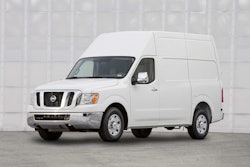With nearly 1.3 million Duramax diesel engines put into operation since its launch in 2000, no other automaker has as much diesel engine development experience for meeting the demands of the heavy-duty truck customer as General Motors.
For 2011, that bar has been raised with new Duramax 6.6L turbo diesel engines, which are offered on the new GMC Sierra Denali HD, 2500HD and 3500HD, as well as commercial chassis cab and box-delete models, launching this summer. There are two versions – one for pickups (engine code LML) and one for chassis cab and box-delete vehicles (engine code LGH).
The Duramax is the most powerful in the heavy-duty pickup segment, with the LML rated at 397 horsepower (296 kW) at 3,000 rpm and 765 lb.-ft. of torque (1,037 Nm) at 1,600 rpm. The LGH is rated at 335 horsepower (249 kW) at 3,100 rpm and 685 lb.-ft. of torque (928 Nm) at 1,600 rpm.
The 2011 Duramax diesel lineup helps make the new Sierra heavy-duty trucks more capable and advances GMC’s 109-year legacy of building capable, durable heavy-duty trucks. Both versions share enhancements that bring:
- Significantly more torque and higher horsepower ratings
- Improved fuel efficiency
- Internal changes that enhance strength and durability
- Engine brake system with the Allison 1000 six-speed transmission
- B20 biodiesel capability.
“Building on a proven architecture, we’ve enhanced the Duramax to make it one of the most competitive and capable engines in the segment – one that takes performance and fuel economy to the next level,” said Gary Arvan, Duramax chief engineer. “Whether it’s a new Sierra Denali HD or an ambulance based on a Sierra chassis cab, customers will find the Duramax is the power behind the greater capability these trucks offer.”
The original Duramax turbo diesel earned its reputation for durability and led the industry with first-in-class common rail fuel injection and aluminum heads with a six-bolt-per-cylinder design. Those attributes formed the foundation for the 2011 engine, with digital modeling and simulation tools used to raise the Duramax’s power and durability benchmarks. It is expected to produce significantly more torque and horsepower than the previous engine, while delivering greater strength and durability.
The internal elements that help enhance strength and durability include:
- The main bearing profiles are changed to enhance oil film thickness
- Oil pump flow is increased for more pressure at low speeds
- The turbocharger’s oil circuit is changed to provide increased pressure at the turbo and faster oil delivery
- The connecting rods’ pin ends are modified to provide increased piston support
- A new, higher-strength piston design eliminates bushings to provide lower reciprocating weight
- An EGR cooler bypass reduces high-mileage soot deposits in the cooler and EGR circuit (LML versions only).
The new Duramax 6.6L improves on an already low-noise reputation with double-pilot injection, a strengthened block and, in some conditions, lower rail pressure, contributing to a nearly 30-percent improvement in noise at the engine level. A new 30,000-psi (2,000 bar) piezo-actuated fuel injection system – capable of operating on ASTM grade B20 biodiesel – ensures more precise fuel delivery, improving emission performance and playing a crucial role in reducing high-speed noise, vibration and harshness.
Greater capabilities, cleaner operation
The new Duramax 6.6L helps boosts towing capacity of the Sierra HD pickups to a maximum of 20,000 pounds (9,072 kg), which is best in class. Power and cooling improvements, along with improvements to the truck chassis, were key elements in boosting the towing rating.
The Duramax 6.6L’s variable vane geometry turbocharger and new Allison 1000 transmission make downhill towing less stressful, too, with the addition of a new engine braking system. The feature creates added backpressure in the exhaust, resulting in negative torque during deceleration and downhill driving, enhancing driver control and prolonging brake pad life.
Significantly, all of the Duramax 6.6L’s improvements in power and towing capability don’t come at the cost of fuel economy. Already respected for its efficiency, the new Duramax turbo diesel helps delivers up to 11-percent greater highway fuel economy than the outgoing vehicle.
The 2011 Duramax will continue to provide outstanding cold-weather performance, with microprocessor-controlled glow plugs capable of gas engine-like start performance in less than three seconds in temperatures as low as -20 degrees F (-29 C), without a block heater.
GMC backs the Duramax with a five-year/100,000-mile powertrain warranty. The engine has been developed to operate for at least 200,000 miles (322,000 km) on a rough-duty cycle without the need for a major overhaul.
“We recognize that a great number of our customers will use the product to its limits. That’s why we design our durability schedules to test for these heavy-towing customers. We also recognize that having any issues when towing large cargo long distances is much more than an inconvenience. That’s why reliability and durability are a top focus for us,” Arvan said.
The Duramax diesel features the latest in emission control technology, making it the cleanest Duramax engine ever produced, with NOx emissions reduced by at least 63 percent with the LML version, compared to the 2010 model. NOx emissions are controlled via a Selective Catalyst Reduction aftertreatment system that uses urea-based Diesel (Emission) Exhaust Fluid (DEF). The DEF is housed in a 5.3-gallon (20 L) tank and needs to be replenished about every 5,000 miles (8,000 km). Electrically heated lines feed the DEF to the emission system to ensure adequate delivery in cold weather.
The 2011 Duramax 6.6L will also include GM’s second-generation diesel particulate filter system. Unlike most of the competition, the Duramax regenerates its diesel particulate filter using a downstream injection of diesel fuel directly into the exhaust stream and can travel up to 700 miles (1,125 km) between regenerations – a 300-mile (482 km) increase over the previous Duramax engine. The use of downstream injection also helps to improve engine life by eliminating concerns surrounding the possibility of diesel fuel contaminating engine oil, which can happen when fuel used for regeneration is introduced directly into the cylinder.
Duramax for commercial trucks
The LGH Duramax for chassis cab models is based on the same improved architecture and includes most of the same features as the LML version, but is engineered to meet federal certification standards for incomplete vehicles, whereas the pickup-based Sierra 2500HD and 3500HD models and complete vans are certified to a different standard. Mostly, that means the LGH is emissions-certified separately from the rest of the vehicle, while the LML is certified in the vehicle, with all of the exhaust and emissions equipment.
To meet the more stringent emissions requirements for 2011, the LGH Duramax features a robust EGR cooling system, along with revised turbocharger tuning that helps enhance EGR performance (the LML has an EGR bypass) and different injector nozzles. The LGH also has a larger-capacity selective catalytic reduction system.
Although it differs slightly from the LML version, the LGH Duramax offers the same key features and benefits, including the exhaust brake system, B20 biodiesel capability and excellent cold-start performance.












